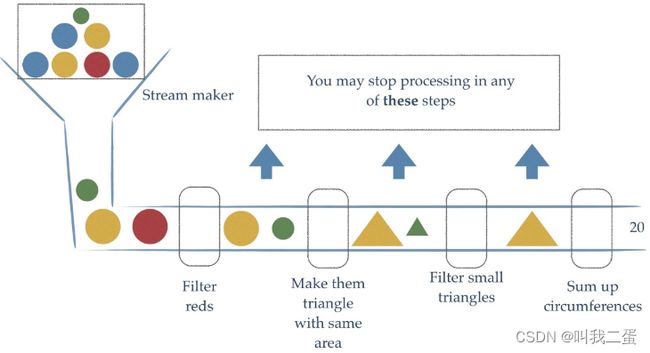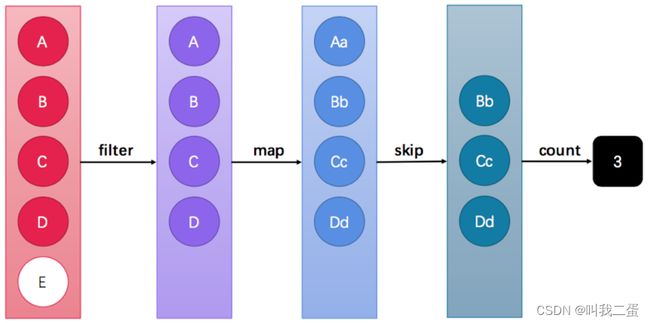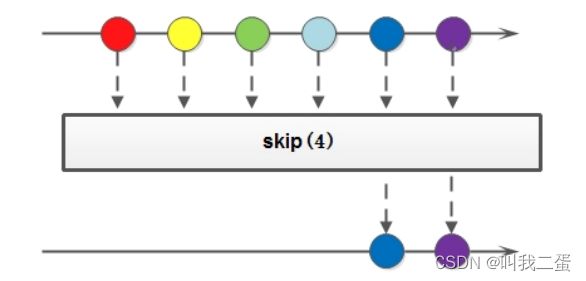JDK8特性——Stream API
文章目录
- 集合处理数据的弊端
- Steam流式思想概述
- Stream流的获取方式
-
- 根据Collection获取
- 通过Stream的of方法
- Stream常用方法介绍
-
- forEach
- count
- filter
- limit
- skip
- map
- sorted
- distinct
- match
- find
- max和min
- reduce
- map和reduce的组合
- mapToInt
- concat
- Stream结果收集
-
- 结果收集到集合
- 结果收集到数组
- 结果聚合计算
- 结果分组
- 结果分区
- 结果拼接
- 并行Stream流
-
- 获取并行流
- 并行流操作
- 并行流和串行流对比
- 线程安全问题
集合处理数据的弊端
当我们在需要对集合中的元素进行操作的时候,除了必需的添加,删除,获取外,最典型的操作就是集合遍历,
public class StreamTest01 {
public static void main(String[] args) {
// 定义一个List集合
List<String> list = Arrays.asList("张三","张三丰","成龙","周星驰");
// 1.获取所有 姓张的信息
List<String> list1 = new ArrayList<>();
for (String s : list) {
if(s.startsWith("张")){
list1.add(s);
}
}
// 2.获取名称长度为3的用户
List<String> list2 = new ArrayList<>();
for (String s : list1) {
if(s.length() == 3){
list2.add(s);
}
}
// 3. 输出所有的用户信息
for (String s : list2) {
System.out.println(s);
}
}
}
上面的代码针对与我们不同的需求总是一次次的循环循环循环,我们希望有更加高效的处理方式,这时我们就可以通过JDK8中提供的Stream API来解决这个问题了。
Stream更加优雅的解决方案:
public class StreamTest02 {
public static void main(String[] args) {
// 定义一个List集合
List<String> list = Arrays.asList("张三","张三丰","成龙","周星驰");
System.out.println("----------");
list.stream()
.filter(s->s.startsWith("张"))
.filter(s->s.length() == 3)
.forEach(System.out::println);
}
}
上面的SteamAPI代码的含义:获取流,过滤张,过滤长度,逐一打印。相比于上面的案例更加的简洁直观。
Steam流式思想概述
注意:Stream和IO流(InputStream/OutputStream)没有任何关系,请暂时忘记对传统IO流的固有印象!
Stream流式思想类似于工厂车间的“生产流水线”,Stream流不是一种数据结构,不保存数据,而是对数据进行加工
处理。Stream可以看作是流水线上的一个工序。在流水线上,通过多个工序让一个原材料加工成一个商品。

对应到集合数据就是这样:

Stream API能快速完成许多复杂的操作,如筛选、切片、映射、查找、去除重复,统计,匹配和归约。
Stream流的获取方式
根据Collection获取
java.util.Collection 接口中加入了default方法 stream,也就是说Collection接口下的所有的实现都可以通过steam方法来获取Stream流。
public static void main(String[] args) {
List<String> list = new ArrayList<>();
list.stream();
Set<String> set = new HashSet<>();
set.stream();
Vector vector = new Vector();
vector.stream();
}
但是Map接口别没有实现Collection接口,那这时怎么办呢?这时我们可以根据Map获取对应的key value的集合。
public static void main(String[] args) {
Map<String,Object> map = new HashMap<>();
Stream<String> stream = map.keySet().stream(); // key
Stream<Object> stream1 = map.values().stream(); // value
Stream<Map.Entry<String, Object>> stream2 = map.entrySet().stream(); // entry
}
通过Stream的of方法
在实际开发中我们不可避免的还是会操作到数组中的数据,由于数组对象不可能添加默认方法,所有Stream接口中提供了静态方法of
public class StreamTest05 {
public static void main(String[] args) {
Stream<String> a1 = Stream.of("a1", "a2", "a3");
String[] arr1 = {"aa","bb","cc"};
Stream<String> arr11 = Stream.of(arr1);
Integer[] arr2 = {1,2,3,4};
Stream<Integer> arr21 = Stream.of(arr2);
arr21.forEach(System.out::println);
// 注意:基本数据类型的数组是不行的
int[] arr3 = {1,2,3,4};
Stream.of(arr3).forEach(System.out::println);
}
}
Stream常用方法介绍
Stream流模型的操作很丰富,这里介绍一些常用的API。
| 方法名 | 方法作用 | 返回值类型 | 方法种类 |
|---|---|---|---|
| count | 统计个数 | long | 终结 |
| forEach | 逐一处理 | void | 终结 |
| filter | 过滤 | Stream | 函数拼接 |
| limit | 取用前几个 | Stream | 函数拼接 |
| skip | 跳过前几个 | Stream | 函数拼接 |
| map | 映射 | Stream | 函数拼接 |
| concat | 组合 | Stream | 函数拼接 |
这些方法可以被分成两种:
终结方法:返回值类型不再是 Stream 类型的方法,不再支持链式调用。本小节中,终结方法包括 count 和 forEach 方法。
非终结方法:返回值类型仍然是 Stream 类型的方法,支持链式调用。
Stream注意事项(重要):
- Stream只能操作一次
- Stream方法返回的是新的流
- Stream不调用终结方法,中间的操作不会执行
forEach
forEach用来遍历流中的数据
void forEach(Consumer<? super T> action);
该方法接受一个Consumer接口,会将每一个流元素交给函数处理
public static void main(String[] args) {
Stream.of("a1", "a2", "a3").forEach(System.out::println);;
}
count
Stream流中的count方法用来统计其中的元素个数的
long count();
该方法返回一个long值,代表元素的个数。
public static void main(String[] args) {
long count = Stream.of("a1", "a2", "a3").count();
System.out.println(count);
}
filter
filter方法的作用是用来过滤数据的。返回符合条件的数据
可以通过filter方法将一个流转换成另一个子集流
Stream<T> filter(Predicate<? super T> predicate);
该接口接收一个Predicate函数式接口参数作为筛选条件
public static void main(String[] args) {
Stream.of("a1", "a2", "a3","bb","cc","aa","dd")
.filter((s)->s.contains("a"))
.forEach(System.out::println);
}
limit
Stream<T> limit(long maxSize);
参数是一个long类型的数值,如果集合当前长度大于参数就进行截取,否则不操作:
public static void main(String[] args) {
Stream.of("a1", "a2", "a3","bb","cc","aa","dd")
.limit(3)
.forEach(System.out::println);
}
skip
如果希望跳过前面几个元素,可以使用skip方法获取一个截取之后的新流

Stream<T> skip(long n);
public static void main(String[] args) {
Stream.of("a1", "a2", "a3","bb","cc","aa","dd")
.skip(3)
.forEach(System.out::println);
}
map
如果我们需要将流中的元素映射到另一个流中,可以使用map方法:
<R> Stream<R> map(Function<? super T, ? extends R> mapper);
该接口需要一个Function函数式接口参数,可以将当前流中的T类型数据转换为另一种R类型的数据
public static void main(String[] args) {
Stream.of("1", "2", "3","4","5","6","7")
.map(Integer::parseInt)
.forEach(System.out::println);
}
sorted
如果需要将数据排序,可以使用sorted方法:
Stream<T> sorted();
在使用的时候可以根据自然规则排序,也可以通过比较强来指定对应的排序规则
public static void main(String[] args) {
Stream.of("1", "3", "2","4","0","9","7")
.map(Integer::parseInt)
//.sorted() // 根据数据的自然顺序排序
.sorted((o1,o2)->o2-o1) // 根据比较强指定排序规则
.forEach(System.out::println);
}
distinct
如果要去掉重复数据,可以使用distinct方法:
Stream<T> distinct();
public static void main(String[] args) {
Stream.of("1", "3", "3","4","0","1","7")
//.map(msg->Integer.parseInt(msg))
.map(Integer::parseInt)
//.sorted() // 根据数据的自然顺序排序
.sorted((o1,o2)->o2-o1) // 根据比较强指定排序规则
.distinct() // 去掉重复的记录
.forEach(System.out::println);
}
Stream流中的distinct方法对于基本数据类型是可以直接出重的,但是对于自定义类型,我们是需要重写hashCode和equals方法来移除重复元素。
match
如果需要判断数据是否匹配指定的条件,可以使用match相关的方法
boolean anyMatch(Predicate<? super T> predicate); // 元素是否有任意一个满足条件
boolean allMatch(Predicate<? super T> predicate); // 元素是否都满足条件
boolean noneMatch(Predicate<? super T> predicate); // 元素是否都不满足条件
public static void main(String[] args) {
boolean b = Stream.of("1", "3", "3", "4", "5", "1", "7")
.map(Integer::parseInt)
//.allMatch(s -> s > 0)
//.anyMatch(s -> s >4)
.noneMatch(s -> s > 4)
;
System.out.println(b);
}
match是一个终结方法
find
如果我们需要找到某些数据,可以使用find方法来实现
Optional<T> findFirst();
Optional<T> findAny();
public static void main(String[] args) {
Optional<String> first = Stream.of("1", "3", "3", "4", "5", "1", "7").findFirst();
System.out.println(first.get());
Optional<String> any = Stream.of("1", "3", "3", "4", "5", "1", "7").findAny();
System.out.println(any.get());
}
max和min

如果我们想要获取最大值和最小值,那么可以使用max和min方法
Optional<T> min(Comparator<? super T> comparator);
Optional<T> max(Comparator<? super T> comparator);
使用
public static void main(String[] args) {
Optional<Integer> max = Stream.of("1", "3", "3", "4", "5", "1", "7")
.map(Integer::parseInt)
.max((o1,o2)->o1-o2);
System.out.println(max.get());
}
reduce
如果需要将所有数据归纳得到一个数据,可以使用reduce方法
T reduce(T identity, BinaryOperator<T> accumulator);
public static void main(String[] args) {
Integer sum = Stream.of(4, 5, 3, 9)
// identity默认值
// 第一次的时候会将默认值赋值给x
// 之后每次会将 上一次的操作结果赋值给x y就是每次从数据中获取的元素
.reduce(0, (x, y) -> {
System.out.println("x="+x+",y="+y);
return x + y;
});
}
map和reduce的组合
在实际开发中我们经常会将map和reduce一块来使用
public static void main(String[] args) {
// 1.求出所有年龄的总和
Integer sumAge = Stream.of(
new Person("张三", 18)
, new Person("李四", 22)
, new Person("张三", 13)
, new Person("王五", 15)
, new Person("张三", 19)
).map(Person::getAge) // 实现数据类型的转换
.reduce(0, Integer::sum);
System.out.println(sumAge);
}
mapToInt
如果需要将Stream中的Integer类型转换成int类型,可以使用mapToInt方法来实现
public static void main(String[] args) {
// 为了提高程序代码的效率,我们可以先将流中Integer数据转换为int数据,然后再操作
IntStream intStream = Stream.of(arr)
.mapToInt(Integer::intValue);
intStream.filter(i->i>3)
.forEach(System.out::println);
}
concat
如果有两个流,希望合并成为一个流,那么可以使用Stream接口的静态方法concat
public static <T> Stream<T> concat(Stream<? extends T> a, Stream<? extends T> b) {
Objects.requireNonNull(a);
Objects.requireNonNull(b);
@SuppressWarnings("unchecked")
Spliterator<T> split = new Streams.ConcatSpliterator.OfRef<>(
(Spliterator<T>) a.spliterator(), (Spliterator<T>) b.spliterator());
Stream<T> stream = StreamSupport.stream(split, a.isParallel() || b.isParallel());
return stream.onClose(Streams.composedClose(a, b));
}
public static void main(String[] args) {
Stream<String> stream1 = Stream.of("a","b","c");
Stream<String> stream2 = Stream.of("x", "y", "z");
// 通过concat方法将两个流合并为一个新的流
Stream.concat(stream1,stream2).forEach(System.out::println);
}
Stream结果收集
结果收集到集合
/**
* Stream结果收集
* 收集到集合中
*/
@Test
public void test01(){
// Stream stream = Stream.of("aa", "bb", "cc");
List<String> list = Stream.of("aa", "bb", "cc","aa")
.collect(Collectors.toList());
System.out.println(list);
// 收集到 Set集合中
Set<String> set = Stream.of("aa", "bb", "cc", "aa")
.collect(Collectors.toSet());
System.out.println(set);
}
结果收集到数组
Stream中提供了toArray方法来将结果放到一个数组中,返回值类型是Object[],如果我们要指定返回的类型,那么可以使用另一个重载的toArray(IntFunction f)方法
/**
* Stream结果收集到数组中
*/
@Test
public void test02(){
Object[] objects = Stream.of("aa", "bb", "cc", "aa")
.toArray(); // 返回的数组中的元素是 Object类型
System.out.println(Arrays.toString(objects));
// 如果我们需要指定返回的数组中的元素类型
String[] strings = Stream.of("aa", "bb", "cc", "aa")
.toArray(String[]::new);
System.out.println(Arrays.toString(strings));
}
结果聚合计算
当我们使用Stream流处理数据后,可以像数据库的聚合函数一样对某个字段进行操作,比如获得最大值,最小值,求和,平均值,统计数量。
/**
* Stream流中数据的聚合计算
*/
@Test
public void test03(){
// 获取年龄的最大值
Optional<Person> maxAge = Stream.of(
new Person("张三", 18)
, new Person("李四", 22)
).collect(Collectors.maxBy((p1, p2) -> p1.getAge() - p2.getAge()));
System.out.println("最大年龄:" + maxAge.get());
// 获取年龄的最小值
Optional<Person> minAge = Stream.of(
new Person("张三", 18)
, new Person("李四", 22)
).collect(Collectors.minBy((p1, p2) -> p1.getAge() - p2.getAge()));
System.out.println("最新年龄:" + minAge.get());
// 求所有人的年龄之和
Integer sumAge = Stream.of(
new Person("张三", 18)
, new Person("李四", 22)
)
//.collect(Collectors.summingInt(s -> s.getAge()))
.collect(Collectors.summingInt(Person::getAge))
;
System.out.println("年龄总和:" + sumAge);
// 年龄的平均值
Double avgAge = Stream.of(
new Person("张三", 18)
, new Person("李四", 22)
).collect(Collectors.averagingInt(Person::getAge));
System.out.println("年龄的平均值:" + avgAge);
// 统计数量
Long count = Stream.of(
new Person("张三", 18)
, new Person("李四", 22)
).filter(p->p.getAge() > 18)
.collect(Collectors.counting());
System.out.println("满足条件的记录数:" + count);
}
结果分组
当我们使用Stream流处理数据后,可以根据某个属性将数据分组
/**
* 分组计算
*/
@Test
public void test04(){
// 根据账号对数据进行分组
Map<String, List<Person>> map1 = Stream.of(
new Person("张三", 18, 175)
, new Person("李四", 22, 177)
).collect(Collectors.groupingBy(Person::getName));
map1.forEach((k,v)-> System.out.println("k=" + k +"\t"+ "v=" + v));
}
多级分组: 先根据name分组然后根据年龄分组
/**
* 分组计算--多级分组
*/
@Test
public void test05(){
// 先根据name分组,然后根据age(成年和未成年)分组
Map<String,Map<Object,List<Person>>> map = Stream.of(
new Person("张三", 18, 175)
, new Person("李四", 22, 177)
).collect(Collectors.groupingBy(
Person::getName
,Collectors.groupingBy(p->p.getAge()>=18?"成年":"未成年"
)
));
map.forEach((k,v)->{
System.out.println(k);
v.forEach((k1,v1)->{
System.out.println("\t"+k1 + "=" + v1);
});
});
}
结果分区
Collectors.partitioningBy会根据值是否为true,把集合中的数据分割为两个列表,一个true列表,一个false列表

/**
* 分区操作
*/
@Test
public void test06(){
Map<Boolean, List<Person>> map = Stream.of(
new Person("张三", 18, 175)
, new Person("李四", 22, 177)
).collect(Collectors.partitioningBy(p -> p.getAge() > 18));
map.forEach((k,v)-> System.out.println(k+"\t" + v));
}
结果拼接
Collectors.joining会根据指定的连接符,将所有的元素连接成一个字符串
/**
* 对流中的数据做拼接操作
*/
@Test
public void test07(){
String s1 = Stream.of(
new Person("张三", 18, 175)
, new Person("李四", 22, 177)
, new Person("张三", 14, 165)
, new Person("李四", 15, 166)
, new Person("张三", 19, 182)
).map(Person::getName)
.collect(Collectors.joining());
// 张三李四张三李四张三
System.out.println(s1);
并行Stream流
前面使用的Stream流都是串行,也就是在一个线程上面执行。
/**
* 串行流
*/
@Test
public void test01(){
Stream.of(5,6,8,3,1,6)
.filter(s->{
System.out.println(Thread.currentThread() + "" + s);
return s > 3;
}).count();
}
parallelStream就是一个并行执行的流,它通过默认的ForkJoinPool,可以提高多线程任务的速度。
获取并行流
我们可以通过两种方式来获取并行流。
- 通过List接口中的parallelStream方法来获取
- 通过已有的串行流转换为并行流(parallel)
/**
* 获取并行流的两种方式
*/
@Test
public void test02(){
List<Integer> list = new ArrayList<>();
// 通过List 接口 直接获取并行流
Stream<Integer> integerStream = list.parallelStream();
// 将已有的串行流转换为并行流
Stream<Integer> parallel = Stream.of(1, 2, 3).parallel();
}
并行流操作
/**
* 并行流操作
*/
@Test
public void test03(){
Stream.of(1,4,2,6,1,5,9)
.parallel() // 将流转换为并发流,Stream处理的时候就会通过多线程处理
.filter(s->{
System.out.println(Thread.currentThread() + " s=" +s);
return s > 2;
}).count();
}
并行流和串行流对比
通过for循环串行Stream流和并行Stream流来对500000000亿个数字求和,看消耗时间
public class Test03 {
private static long times = 500000000;
private long start;
@Before
public void befor(){
start = System.currentTimeMillis();
}
@After
public void end(){
long end = System.currentTimeMillis();
System.out.println("消耗时间:" + (end - start));
}
/**
* 普通for循环 消耗时间:138
*/
@Test
public void test01(){
System.out.println("普通for循环:");
long res = 0;
for (int i = 0; i < times; i++) {
res += i;
}
}
/**
* 串行流处理
* 消耗时间:203
*/
@Test
public void test02(){
System.out.println("串行流:serialStream");
LongStream.rangeClosed(0,times)
.reduce(0,Long::sum);
}
/**
* 并行流处理 消耗时间:84
*/
@Test
public void test03(){
LongStream.rangeClosed(0,times)
.parallel()
.reduce(0,Long::sum);
}
}
通过案例可以看到parallelStream的效率是最高的。
Stream并行处理的过程会分而治之,也就是将一个大的任务切分成了多个小任务,这表示每个任务都是一个线程操作。
线程安全问题
在多线程的处理下,肯定会出现数据安全问题。如下:
@Test
public void test01(){
List<Integer> list = new ArrayList<>();
for (int i = 0; i < 1000; i++) {
list.add(i);
}
System.out.println(list.size());
List<Integer> listNew = new ArrayList<>();
// 使用并行流来向集合中添加数据
list.parallelStream()
//.forEach(s->listNew.add(s));
.forEach(listNew::add);
// 839
System.out.println(listNew.size());
}
输出或者直接抛异常
java.lang.ArrayIndexOutOfBoundsException
at sun.reflect.NativeConstructorAccessorImpl.newInstance0(Native Method)
at sun.reflect.NativeConstructorAccessorImpl.newInstance(NativeConstructorAccessorImpl.java:62)
at sun.reflect.DelegatingConstructorAccessorImpl.newInstance(DelegatingConstructorAccessorImpl.java:45)
at java.lang.reflect.Constructor.newInstance(Constructor.java:423)
at java.util.concurrent.ForkJoinTask.getThrowableException(ForkJoinTask.java:598)
....
Caused by: java.lang.ArrayIndexOutOfBoundsException: 366
at java.util.ArrayList.add(ArrayList.java:463)
针对这个问题,我们的解决方案有哪些呢?
- 加同步锁
- 使用线程安全的容器
- 通过Stream中的toArray/collect操作
加同步锁
/**
*
*/
@Test
public void test02(){
List<Integer> listNew = new ArrayList<>();
Object obj = new Object();
IntStream.rangeClosed(1,1000)
.parallel()
.forEach(i->{
synchronized (obj){
listNew.add(i);
}
});
System.out.println(listNew.size());
}
使用线程安全的容器
/**
* 将线程不安全的容器转换为线程安全的容器
*/
@Test
public void test04(){
List<Integer> listNew = new ArrayList<>();
// 将线程不安全的容器包装为线程安全的容器
List<Integer> synchronizedList = Collections.synchronizedList(listNew);
Object obj = new Object();
IntStream.rangeClosed(1,1000)
.parallel()
.forEach(i->{
synchronizedList.add(i);
});
System.out.println(synchronizedList.size());
}
通过Stream中的toArray/collect操作
/**
* 我们还可以通过Stream中的 toArray方法或者 collect方法来操作
* 就是满足线程安全的要求
*/
@Test
public void test05(){
List<Integer> listNew = new ArrayList<>();
Object obj = new Object();
List<Integer> list = IntStream.rangeClosed(1, 1000)
.parallel()
.boxed()
.collect(Collectors.toList());
System.out.println(list.size());
}





